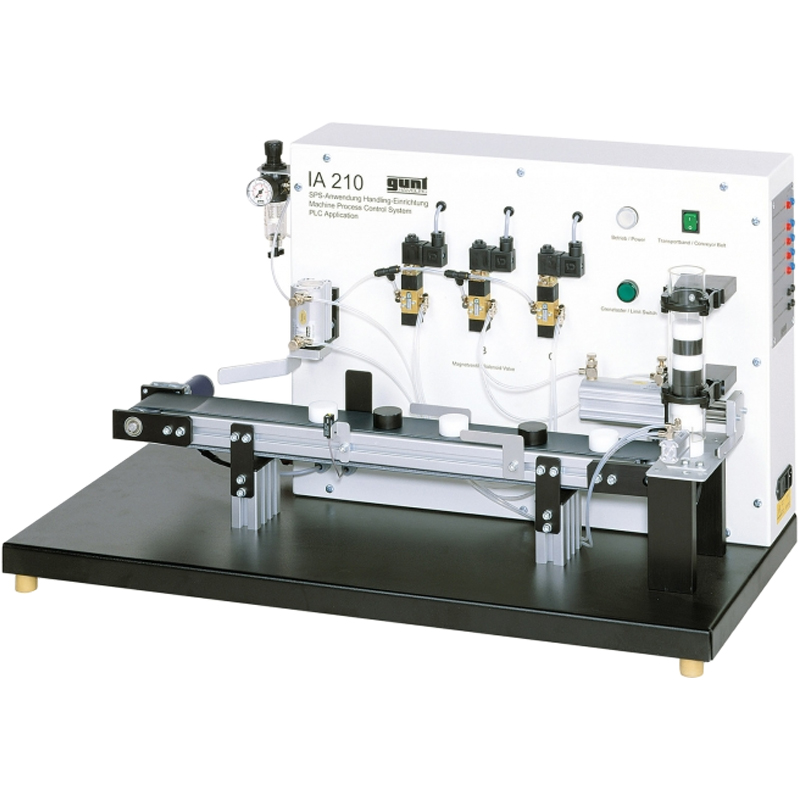DESCRIPTION
Technical Description
IA 210 is a compact teaching and practice unit for the control of a materials handling process using a PLC. Two processes can be simulated: a punching process, or workpiece control in the form of a sort operation. All components are in a clearly laid out design.
Black and white cylindrical workpieces are fed from a container onto a conveyor belt. On the belt is a reflex photoelectric proximity switch which differentiates between light and dark and feeds the white items to the pre-selected process (punching or sorting). The black workpieces are always carried to the end of the belt, where they drop into a collector. Three 5/2-way solenoid valves, three double-acting cylinders and a pneumatic roller pushbutton can be operated via the PLC to execute the necessary steps: releasing the workpiece from the container; pushing the workpiece onto the conveyor belt; sorting or punching the workpiece. For punching, the workpiece is brought to a predefined position. The working cylinder can switch between sorting and punching modes by a simple sequence of actions.
The unit is designed for operation in conjunction with a PLC module. Use of PLC module IA 130 is recommended.
The well-structured instructional material sets out the fundamentals and provides a step-by-step guide through the experiments.
Learning Objectives / Experiments
- familiarisation with and analysis of an automated materials handling process
* understanding and analysis of the mechanical,pneumatic and electrical functions
* familiarisation with the symbols, terms and modes of representation of pneumatic and electrical function diagrams
* familiarisation with automation components: cylinders, solenoid valves, photoelectric proximity switches
- familiarisation with the use of a PLC
* basic methods of programming
* adapting the program to the given handling process
- simulation of a punching process
* conveyor belt is stopped for punching
* conveyor belt also stops as soon as workpiece drops from belt end
- workpiece control simulation
* light-coloured workpieces are separated out; dark items reach the belt end
FEATURES
Specification
[1] compact unit for experiments in the field of automation
[2] handling device with solenoid valves
[3] double-acting cylinder (15mm stroke): fixing / discharge of workpieces to container
[4] double-acting cylinder (80mm stroke): pushes workpiece onto conveyor belt
[5] double-acting cylinder (40mm stroke): executes the process (sorting or punching)
[6] conveyor belt with guide plates and DC motor
[7] cylindrical Plexiglas storage container holding 11 workpieces
[8] 15 workpieces made of Polyoxymethylene (POM): 10x white, 5x black
[9] pneumatic components fitted with quick-release couplings for 4mm hoses
[10] operation of actuators with compressed air
[11] lab jacks to external PLC
[12] set of laboratory cables and pneumatic hoses
[13] compressed air supply: max. 6bar, 3bar recommended
Technical Data
3 electrically operated 5/2-way valves
- with spring return
- with pilot valve
Reflex photoelectric proximity switch
- pnp, light-switching
- 5...150mm
Geared DC motor
- reduction ratio: 142,5:1
- nominal torque 5,92Nm
- nominal speed: 22min-1
Polyester weave conveyor belt
Workpieces, DxH: 40x20mm
Dimensions and Weight
LxWxH: 1000x450x580mm
Weight: approx. 46kg Required for Operation 230V, 50/60Hz, 1 phase or 120V, 60Hz/CSA, 1 phase
Compressed air supply: max. 6bar, 3bar recommended
Scope of Delivery
1 experimental setup, complete,
15 workpieces
1 set of laboratory cables
2 collector bins
1 set of instructional material




